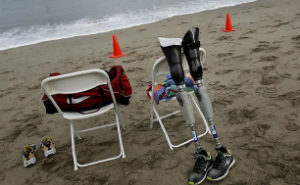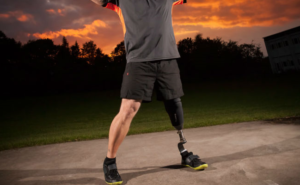Discover the differences between an electric prosthetic arm and a body-powered prosthetic arm to help you decide which type of arm prosthesis is best for your unique needs.
For arm amputees, being fitted for an upper limb prosthesis is an important first step to recovery and regaining independence. One decision patients need to make regarding a prosthetic arm, however, is between an electric or body-powered prosthesis. Understanding the primary differences between these options will help you make the right decision for your needs.
Understanding Electric Arm Prostheses
Electric prostheses, also commonly referred to as myoelectric prostheses, are controlled using electric signals that are actually created by your body’s muscles.
- Specifically, these prosthetics work by using your existing muscles in your residual limb to control the functions of the prosthetic device itself.
A sensor within the device is able to:
- Obtain electrical signals from these muscles.
- Translate those signals into movements.
- Execute the demands properly.
These can be a great option for those who want a natural-looking prosthesis that utilizes existing nerves for functional use.
On the other hand, this upper limb prosthesis tends to be more expensive than a body-powered arm prosthesis, and it can take a longer adjustment period to become familiar to the body. Furthermore, the power source that operates the prosthesis does need to be charged regularly or may need battery replacement on occasion.
Understanding Body-Powered Arm Prostheses
A body-powered prosthesis relies on a system of cables or harnesses (along with manual controls, in many cases) to control the limb itself. Essentially, you operate and control the prosthetic arm using other parts of your body, such as your shoulders, elbows, or chest.
For many patients:
- Body-powered prostheses are a practical option because they tend to be more affordable than myoelectric options and do not rely on an outside power source to operate.
- Body-powered arm prostheses also make for an excellent secondary device, as they are great for use in more rugged environments and are ideal for getting specific tasks done.
It should be noted that this option typically does come with a sacrifice in fine motor skills and precision, so it is not the best option for everybody.
Which Option is Right For You?
Now that you have a better idea of the differences between these two types of prosthetic arms, you may be in a better position to decide which option is best for you. Still, there are some additional considerations worth keeping in mind to help you reach a decision, such as:
- What you will mostly be using the prosthesis for.
- Specific job duties or daily obligations.
- Ability/willingness to charge a myoelectric device.
- Ruggedness/durability required in the prosthesis.
You may also want to consider the specific level of your amputation, as some levels may make you a more suitable candidate for an electric prosthetic than others. These, along with other important factors, can be discussed with your prosthetist to ultimately make a sound decision. In some cases, it may make the most sense to have both types of prostheses:
- One that you use the majority of the time.
- A secondary option for certain tasks.
When you need help making a decision on what type of prosthetic arm to choose, come to the experts. For more information on electric and body-powered prostheses or for assistance with your prosthesis, contact Horton’s Orthotics & Prosthetics. We have been proudly serving people with orthotic and prosthetic needs since 1981; with the most advanced fabrication facility in Arkansas, we are ready to get started on your custom prosthesis.
[maxbutton name=”Download Prosthetics 101″]



Leave a Reply